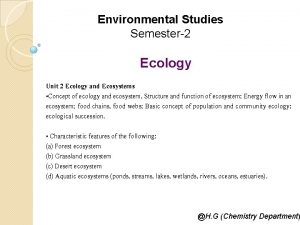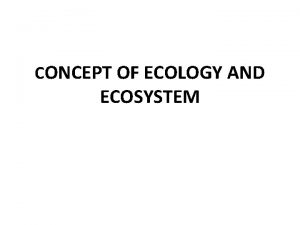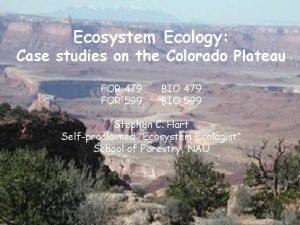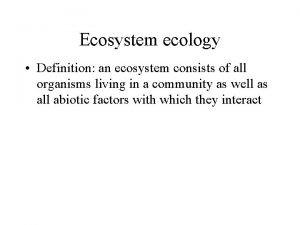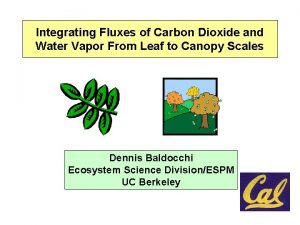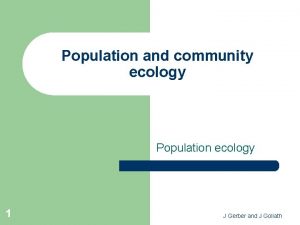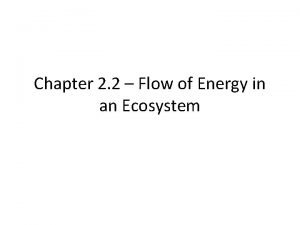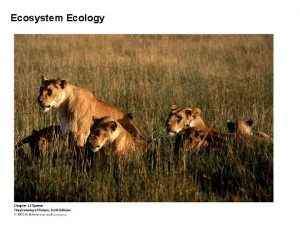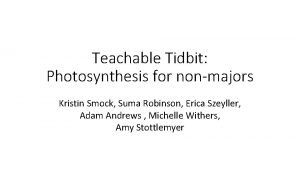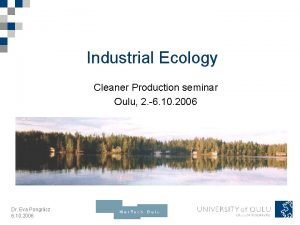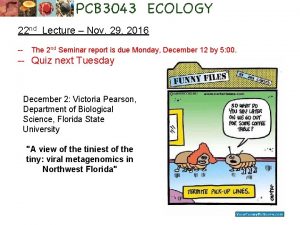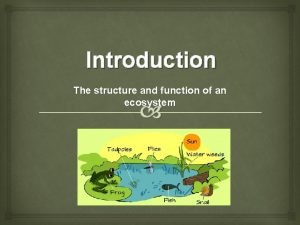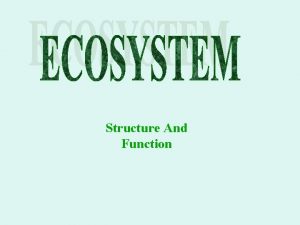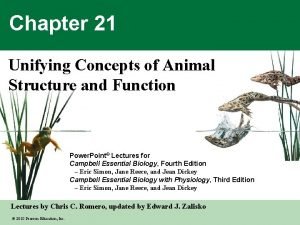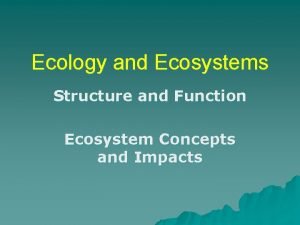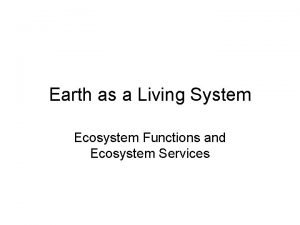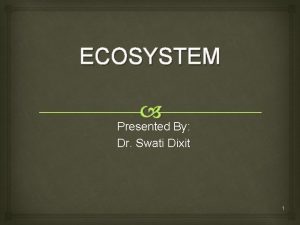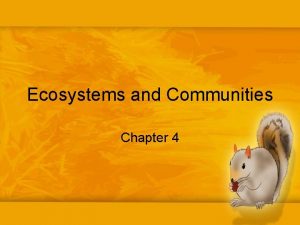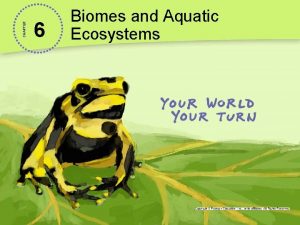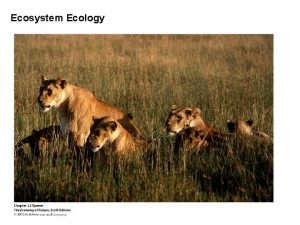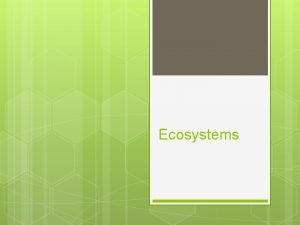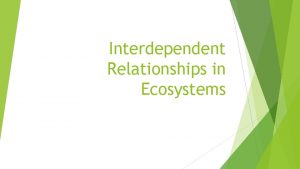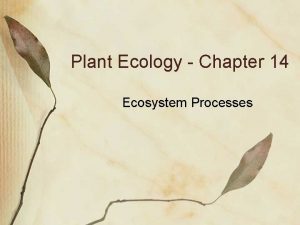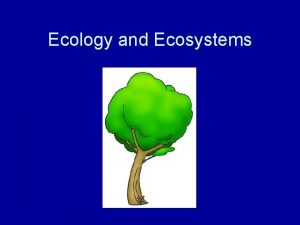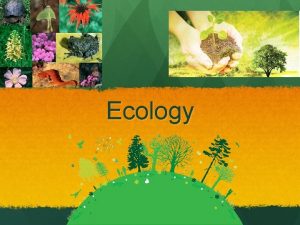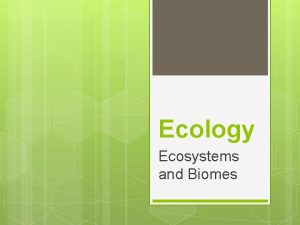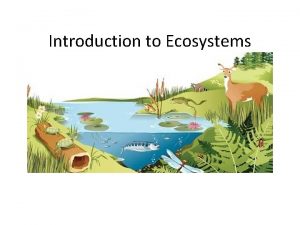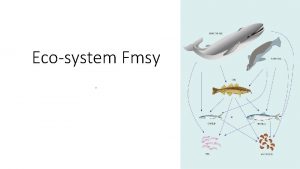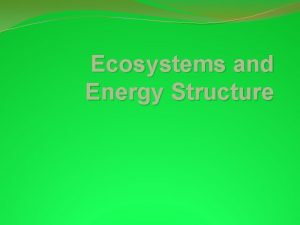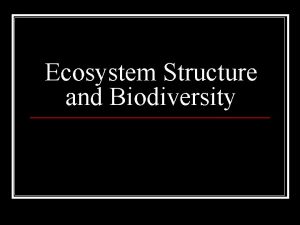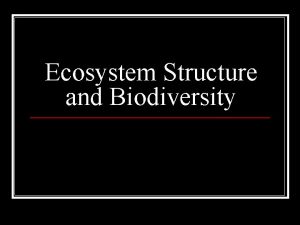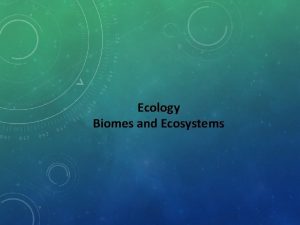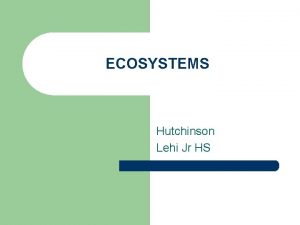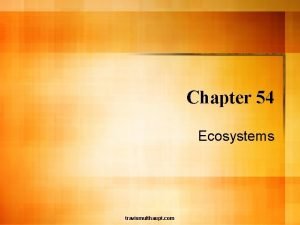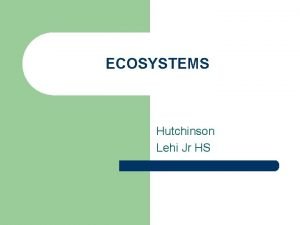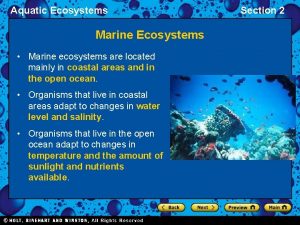Ecology and Ecosystems Structure and Function Ecosystem Concepts

























- Slides: 25

Ecology and Ecosystems Structure and Function Ecosystem Concepts and Impacts

Structure and Function The structure of ecosystems comprises all it’s species. The greater the biodiversity, the more complex the structure The function of ecosystems includes energy flow and biogeochemical cycling Perturbations to ecosystems that significantly affect structure will affect function. Perturbations that significantly affect function will affect structure.

Structure and Function The biological organization of the ecosphere ranges from molecules and cells in organisms to the entire biological community of the Earth. Biosphere Ecosystems Communities An ecosystem can be defined by “natural boundaries” that define a recognizable unit of structure and function Populations Organisms

Structure and Function Ecosystems comprise biological and physical/chemical compartments that constantly interact hydrosphere atmosphere biosphere lithosphere

Structure and Function The structure and function of all ecosystems is driven by the quantity and quality of energy input. For most ecosystems, the ultimate energy source is solar radiation. Energy received by ecosystems is used to build trophic structure and biodiversity and to cycle materials through ecosystems.

Energy Flow - the Earth System u Energy is constantly being emitted by the sun (mostly as light) and travels through space at about 186, 000 miles/sec. u Fortunately for us, the Earth get in the way of a small fraction of that light, and this energy drives a good part of the Earth System. u Of the light that we intercept, about 34 % of it is reflected back out to space, mostly by cloud tops, but also by brightly colored land surfaces. u The remaining energy is left to interact within the Earth System u We refer to this interaction as the “Heat Budget”.

Heat Budget Energy in = Energy out Solar radiation Reflected Light (34%) Reflected by atmosphere (34%) Radiated by atmosphere as heat (66%) UV radiation Absorbed by ozone Lower Stratosphere Greenhouse (ozone layer) Visible effect light Troposphere Heat radiated by the earth Absorbed by the earth Earth Light absorbed by the oceans (23%) Light absorbed by the Land (42%) Light absorbed by Photosynthesizers (0. 2%) Heat re-radiated back out to space (66%)

Carbon cycle Phosphorus cycle Nitrogen cycle Water cycle Heat in the environment Heat Oxygen cycle Biogeochemical Cycles Biosphere

Structure and Function Trophic structure describes the relative abundance of species at increasing levels of distance from the source of energy in a food web. Ecosystems with high biodiversity have many different species that occupy the same trophic level. This is why high biodiversity provides complex structure to ecosystems. Trophic structure, determined by biodiversity determines how energy flows through an ecosystem.

Heat Abiotic chemicals (carbon dioxide, oxygen, nitrogen, minerals) Heat Solar energy Heat Trophic level Decomposers (bacteria, fungus) Heat Producers (plants) Consumers (herbivores, carnivores) Trophic level Heat Trophic level

producers Energy from sunlight HEAT NUTRIENTS primary consumers detritus feeders and decomposers HEAT higher-level consumers HEAT

1. A. Energy Flow Through the Biosphere Food Chains Food Chain—Community of Organisms Formed by Trophic Levels 1. 2. 3. 4. 5. First Trophic Level—Producers Second Trophic Level—Primary Consumers (Herbivores) Third Trophic Level—Secondary Consumers (Carnivores) Fourth Trophic Level—Tertiary Consumers Decomposers (Microconsumers)—operate at each trophic level u NOTE— The amount of total energy passed from one level to the next is decreased (because of heat loss) u The number of organisms at each successive level is less u The total biomass decreases at each successive trophic level.

Freshwater Aquatic Food Chain Energy Pyramid Tertiary Consumers-> Secondary Consumers -> Primary Producers -> Note how the total amount of energy (Kcal/m 2/yr) available at each higher level decreases. . .

Tropical Rain Forest Biomass Pyramid Notice that the total producer biomass (mass of biologic material) is tremendously large. There is also a significant decomposer biomass because nutrients are recycled extremely fast in these kinds of ecosystems.

Humans Antarctic Food Web Blue whale Sperm whale Killer whale Elephant seal Crabeater seal Although highly simplified in this diagram, complex communities in ecosystems have high biodiversity with many species at the same trophic level. Leopard seal Emperor penguin Adélie penguins Petrel Squid Fish Carnivorous plankton Herbivorous zooplankton Krill Phytoplankton

Heat Tertiary consumers (human) Heat Decomposers Heat 10 Secondary consumers (perch) 100 1, 000 Heat Primary consumers (zooplankton) 10, 000 Producers Usable energy (phytoplankton) Available at Each tropic level (in kilocalories) Heat The loss of energy at each step up the trophic ladder produces a biomass pyramid in most ecosystems

tertiary consumer 1 cal secondary consumer 10 cal 1000 cal primary consumer producer

1. A. How Do Materials Cycle Through The Earth System? Biogeochemical Cycling 1. 2. Cycling involves biological, geologic, and chemical factors. Three Main Categories a. b. c. B. Hydrologic Gaseous Sedimentary Hydrologic Cycle…The Important issues are. . . 1. 2. 3. The quality of water available to humans The availability of water for human use The rate at which water flows through the cycle.

water vapor in atmosphere evaporation from land from transpiration ocean from plants precipitation over land surface runoff groundwater seepage precipitation over ocean water in ocean (reservoir)

Other Materials Cycles C. Gaseous Cycles 1. 2. Exchanges among the atmosphere, biosphere, soils and oceans Most significant gaseous cycles include: a. b. c. D. Sedimentary Cycles 1. 2. Involve materials that move from land to oceans and back Most significant sedimentary cycles include: a. b. a. Carbon Cycle Oxygen Cycle Nitrogen Cycle Phosphorous cycle Sulfur cycle A few examples. . .

heat radiated into space outer space sunlight heat trapped in atmosphere CO 2 CFCs methane nitrous oxide atmosphere volcano forest fires factories vehicle emissions houses cows


Nutrient cycling 2. Greenhouse effect a. Human interference with the carbon cycle b. 1) Use of fossil fuels 2) Global deforestation by burning Global warming 1) Potential consequences of global warming

The Nitrogen Cycle Soil Bacteria are the key to cycling nitrogen gas from the atmosphere to more useable forms such as ammonium and nitrate. It is estimated that human activities have at least doubled the rate at which nitrogen enters the worlds soils. How? Why?

Nutrient cycling u Human impact on nutrient cycles 1. Acid rain a. Sulfuric and nitric acids as a result of overloading N and S cycles b. Acid rain examples 1) Adirondack Mountains—dead lakes 2) Mount Mitchell, N. C. —fog p. H = 2. 9
 Chapter 55 ecosystems and restoration ecology
Chapter 55 ecosystems and restoration ecology Chapter 55 ecosystems and restoration ecology
Chapter 55 ecosystems and restoration ecology Difference between ecosystem and ecology
Difference between ecosystem and ecology Difference between ecosystem and ecology
Difference between ecosystem and ecology Ecology and ecosystem
Ecology and ecosystem Primary and secondary production in ecosystem
Primary and secondary production in ecosystem Ecosystem ecology
Ecosystem ecology Ecosystem ecology
Ecosystem ecology Principles of ecology 2 flow of energy in an ecosystem
Principles of ecology 2 flow of energy in an ecosystem Ecological productivity
Ecological productivity Ecosystem ecology
Ecosystem ecology Ecology ecosystem
Ecology ecosystem Ecosystem ecology
Ecosystem ecology Structure and function of an ecosystem
Structure and function of an ecosystem Structure of ecosystem ppt
Structure of ecosystem ppt Unifying concepts of animal structure and function
Unifying concepts of animal structure and function Function of ecosystem
Function of ecosystem Function of ecosystem
Function of ecosystem Ecosystem structure
Ecosystem structure Ecosystems and communities chapter 4 answer key
Ecosystems and communities chapter 4 answer key The chaparral biome is best characterized by _______.
The chaparral biome is best characterized by _______. 6 biomes and aquatic ecosystems answers
6 biomes and aquatic ecosystems answers Chapter 42 ecosystems and energy
Chapter 42 ecosystems and energy Chapter 3 lesson 3 biomes and aquatic ecosystems
Chapter 3 lesson 3 biomes and aquatic ecosystems Frog life cycle
Frog life cycle Energy flow trophic levels
Energy flow trophic levels


